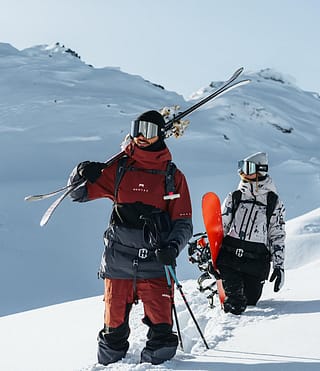What to wear skiing and snowboarding
First time on the slopes? Or are you just looking to dial in your layering? Then check out our essential guide on what to wear skiing and snowboarding.

We’re always asked what to wear skiing and snowboarding. And with different base layers, fleeces and puffer jackets, insulated outerwear, and ‘technical shells’, it all can feel a bit much, right?
Don’t worry! We’ve broken down everything you need to know and made sure our quick-fire guide is simple and valuable. So, feeling ready to hit the mountain in comfort? Dig into our article and perfect your riding setup this season.
How to dress for skiing and snowboarding
Base layers

You’ll 100% need base layers. These are form-fitting, thin layers you wear next to your skin. They form the ‘base’ of your layering setup (hence the name) and are often made from Merino wool or synthetic fabrics for their breathable properties.
Wicking away moisture (such as sweat) is an essential base layer skill, as it’s key to keeping you dry. If you’re damp and clammy while riding, you’ll ultimately get cold, as water conducts heat away from the body 50 times faster than air.
It might be tempting, but cotton base layers are never the right choice. You’ll find they’re highly absorbent with zero breathability – so you can kiss comfort goodbye!
Mid layers
Your mid layer is a fleece or puffy jacket worn over your base layer and under your snow jacket. You might skip a mid layer depending on your jacket, the conditions, and how warm you run. However, most riders wear one as part of their layering setup.
A lightweight fleece or breathable puffer jacket offers boosted insulation from the cold, as both help to trap an extra layer of warm air. And, generally, a puffer jacket is the warmest choice.
However, if you’re in milder conditions, choose a fleece for its insulating properties and breathability. Oh, and avoid cotton sweaters or hoodies for the same reason as cotton base layers.
Ski and snowboard jacket
Your ski and snowboard jacket protects you from elements like wind, snow, and even rain. Should you pick an insulated or a shell ski jacket? Insulated jackets have a built-in layer of insulation to help keep you warm, while shell jackets don’t. Around 60gsm is a reliable level of insulation, providing an acceptable amount of warmth without feeling too bulky. Depending on whether you choose insulated or shell, you might want to add or remove your mid layer. Feel too warm? Use your ventilation zips to cool down. Unsure whether you’ll need a mid layer? Carry a small backpack with one in it.
Another thing to consider is the jacket’s waterproofing (measured in ‘mm’) and breathability (measured in ‘g’). These figures dictate how waterproof and breathable it is. For example, higher numbers are better.
You also want a jacket with a DWR (‘Durable Water Repellent’) treatment for extra weather protection. Plus, look for an excellent range of features, such as an adjustable hood, ventilation zips, snow/powder skirt, and plenty of storage options.
Ski and snowboard pants

Ski and snowboard pants are up next. And you’ll need to decide whether you want insulated or shell pants and a bib design. Like your ski jacket, insulated pants have a built-in layer of compact insulation. Riding in super cold conditions or on the East Coast during a sub-zero spell? Insulation is an excellent choice!
However, most people don’t need insulation for their bottom halves, as your legs work hard and generate lots of heat. So, selecting a pair of shell pants gives you a little more freedom of movement, as they’re slightly less bulky.
Choosing between a bib or classic pants style falls down to preference. Bibs don’t have traditional waistbands, so you’ll experience less pressure around the midsection. A bib also provides more powder protection and storage than classic pants. Plus, you’ll have more coverage and be slightly warmer. But remember, bibs come with suspenders. That means they’re a little more work to take on and off – which is why some riders prefer the simplicity of classic snow pants instead.
Other essentials
Let’s look at other essential items and accessories you’ll need while riding.
Gloves
Hit the hill with snow gloves or mittens – most of which are insulated and waterproof. Cheaper gloves have a plastic membrane in them that makes them waterproof. However, this means they aren’t breathable, so your hands become super sweaty! Higher quality gloves are made with waterproof materials, keeping your hands dry and letting them breathe. A DWR coating also improves waterproofing without affecting breathability.
When it comes to mittens versus gloves, it’s down to preference. Mittens are slightly warmer, and gloves can be a little more dexterous. However, there’s not much of a difference. Struggle with freezing hands? Consider a thin pair of liner gloves under your snow gloves. These are also usually touchscreen compatible, so you can work your phone without exposing your fingers to the open air. Handy, right?
Goggles
Goggles are key to life on the mountain. They protect your eyes from snow, sun, wind, and foreign objects, like tree branches or even shards of ice. Most goggles come with various colored lenses relating to the light conditions. These lenses have a VLT (‘Visible Light Transmission’) score that’s represented as a percentage figure. Higher numbers mean the lens lets more light in, so these goggles are better for lower or flat light conditions. On the other hand, low VLT is best for bright conditions.
For shape and style, it’s down to preference. Different lens shapes don’t really affect the performance. Instead, you want goggles that fit your face well, don’t hurt your peripheral vision, and have an excellent helmet fit with no major gaps.
Facemask
A facemask is a super important item to add to your riding setup. Depending on the style, you’ll find ergonomic masks that fasten behind your head or ‘tube’ style masks that sit around your neck. Pull these tube masks up to protect your face from the cold, wind, and snow and warm your neck.
Facemasks are often made from a weather-protecting polyester softshell. They should be snug enough not to fall down but loose enough not to restrict your breathing. You can tuck most facemasks under your goggles for further protection, and some feature little holes to allow better airflow.
Beanie
A beanie is the final part of your snow setup. It’s perfect for après sessions and those times between descents. While some people wear a beanie under their helmet, it’s not necessary. A helmet should be snug to your head to be most effective, so if you can fit a beanie underneath your helmet, it’s likely too large. As such, beanies are better used for fashion and warmth when you’re not riding.
Beanies can be made from acrylic, polyester, or wool, boosting warmth in cold weather. And most beanies are small enough to fold into a pocket. If you’d rather not ride with one, though, it’s totally fine to rock your helmet hair at the bar!
FAQs

Let’s cover some quick-fire frequently asked questions to help ease any doubts.
How many layers do I need?
This can vary depending on the conditions, the number of layers you own, and how much you feel the cold or heat. Typically, though, two or three layers are the best choice.
A base, mid, and outer layer setup is ideal for colder conditions and colder people. However, if you have an insulated jacket or you're riding in milder conditions, two layers work fine, with a base layer and outerwear offering adequate protection. Do you find wearing a fleece or puffy jacket makes you too warm, but not having a midlayer is too cold? Look at a vest or thin hiking mid layer for that sweet spot.
Should I buy an insulated ski jacket?
This depends on you. If you get cold easily, you’re riding in sub-zero temperatures, or you want to simplify your layering and skip the mid layer, then an insulated ski jacket is a good choice. However, some riders prefer the versatility of a shell jacket, as you can control your layers underneath and tweak how warm or cold you are.
It’s really down to preference, and many riders own insulated and non-insulated ski and snowboard jackets for different conditions. Overall, if you’re planning one jacket for everything, a shell jacket offers more adaptability than an insulated one.
What do I wear in different conditions?
Luckily, a reliable ski or snowboard jacket should have the proper waterproof rating to withstand all conditions. And 15,000mm or above is more than enough to deal with snow or rain.
Temperature is trickier to navigate, as everyone is different and feels the cold to varying degrees. And there’s no temperature range to reference in terms of layering. However, it’s always better to be too warm – and able to take a layer off – than too cold and not have an extra layer to put on. And don’t forget – unzip your zipped puffy or fleece to cool down. Over time, you’ll get to know your body and the mountains and won’t even think about this question!
Wrapping up
Hopefully, you now know how to start layering for your next trip. However, we can’t stress enough how different everyone is and how the cold rarely affects two people the same. And, sometimes, you need to think about more than just the temperature. For example, windchill and even humidity play a part, too! So, finding out what to wear skiing and snowboarding is more about experimentation, learning, and personal preference. Whatever you’re wearing, though, make sure it’s reliable and high quality for when the weather changes quickly. Because it usually does!
Need more information or have a specific question about this article, layering, or anything snow-related? Reach out to crew@montecwear.com, and we’ll gladly answer any queries. Otherwise, thanks for checking out our guide, and be safe out there!
Women's ski clothing
Men's ski clothing
Related reading













